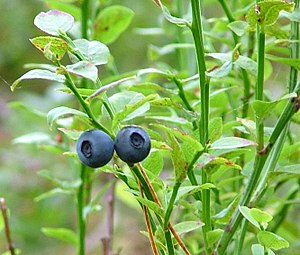
- Image via Wikipedia
Bilberry (Vaccinium myrtillus) contains varying levels of phenolic compounds – anthocyanins, chlorogenic acid derivatives, hydroxycinnamic acids, flavonol glycosides, catechins, and proanthocyanidins. Research by Martz et al (2010) elucidated how levels of bilberry leaf phenolics differed along an ecological gradient in boreal forests running north to south in Finland. These regions differ in latitude, altitude, over story cover, levels of continuous light, temperature and associated frost spells.
An analysis of bilberry leaves showed that major phenolic changes in bilberry leaves appeared in the first stages of leaf development. As important, synthesis and accumulation of flavonoids was delayed in the forest compared to the high light sites. Two-fold higher flavonoid levels appeared in leaf tissue growing in high-light intensity sites, higher latitudes, and/or higher altitudes compared to in lower altitudes and low-light intensity sites.
Close and Mcarther (2002) previously theorized that the presence of greater phenolic levels in leaf tissue found in northern regions was a response to colder temperatures, which would limit essential enzyme function, during periods of maximal photo-oxidative stress (Close and Mcarther, 2002). However, Martz et al (2010) also showed that leaf flavanoid genes were highly expressed in shade, but that the timing of expression appeared to alter the relative metabolite levels in shade compared to sun exposed bilberry leaf.
Mudge et al., (2016), researched phenolic profiles of wild elderberry fruits (Sambucus nigra subsp. canadensis) over two years in eastern US, noting that flavanols (quercitin, isoquercitin, rutin) and chlorogenic acid metabolite concentrations were higher in the southeast, particularly interior. They suggested the variation of phytochemical profiles of the berries were impacted by genetic or environmental factors without understanding on which was more important.
What’s missing from the data picture includes a more complex measurement of ecological influences, such as response to herbivory and rhizosphere fungal associations? This type of whole community data would help to build a more complete picture of plant response.
This requires sampling, sampling, sampling.
_______________________________________________
- Martz, F., Jaakola, L., Julkunen-Tiitto, R. and Stark, S. (2010). Phenolic Composition and Antioxidant Capacity of Bilberry (Vaccinium myrtillus) Leaves in Northern Europe Following Foliar Development and Along Environmental Gradients. J Chem Ecol, published online, 19 August 2010
- Close, D.C., and Mcarther, C. (2002). Rethinking the role of many plant phenolics—protection from photodamage not herbivores? Oikos. 99:166–172
- Mudge, E., Applequist, W. L., Finley, J., Lister, P., Townesmith, A. K., Walker, K. M., & Brown, P. N. (2016). Variation of Select Flavonols and Chlorogenic Acid Content of Elderberry Collected Throughout the Eastern United States. Journal of food composition and analysis : an official publication of the United Nations University, International Network of Food Data Systems, 47, 52–59.


